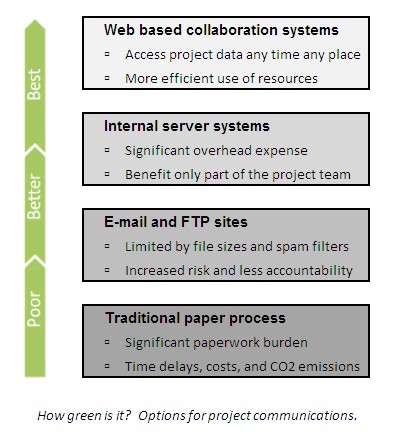Green Construction in the Cloud
Video
alt=""Much focus is being given in the design and construction industry to making projects greener. As an architect myself, I feel an obligation to be conscious of the impact my work and the work of my peers has on the future of our environment. Architects, engineers, builders, and facility owners play a vital role in creating a greener future. Architecture 2030 estimates that in the US alone, buildings are responsible for 48% of greenhouse gas emissions annually and consume 76% of all electricity generated by power plants.

There is no single solution to make an individual project or the AEC industry as a whole greener. Rather, there are ten thousand individual solutions, each forming a piece of the puzzle. It is the job of the project team and of industry leaders to put those pieces together as appropriate for each circumstance.
One item that should be on the list of solutions is the use of Internet-based cloud computing software. Also known as Integrated Project Collaboration (IPC) software, web-based information sharing solutions play an important role in the “greening” of our industry.
First, from a technology perspective, web-based software systems allow firms to utilize the best technology without the hard costs or environmental burden of adding to in-house servers. When done properly, web-based software is inherently greener than in-house servers and software due to a more efficient utilization of resources. Most in-house servers are never fully utilized; meaning energy is being wasted to maintain computing power that is not needed. In addition, the servers will eventually end up in a landfill, creating environmental waste. In contrast, companies can be much more efficient with resources by using a “Software as a Service” (SaaS) approach where they lease software delivered through the Internet, instead of purchasing software that will be outdated and need to be replaced in two years as well as continually adding to their in-house hardware collection to run the software. Additional information can be found in a great article written by Curt Finch, “Go SaaS, Go Green."
 Second, from an AEC project perspective, web-based software systems allow you to place critical project information in a shared location where all project team members have equal access. This results in transparency and better decision making, as well as increasing accountability, since all team members can see what is happening and when decisions are made or feedback is shared.
Second, from an AEC project perspective, web-based software systems allow you to place critical project information in a shared location where all project team members have equal access. This results in transparency and better decision making, as well as increasing accountability, since all team members can see what is happening and when decisions are made or feedback is shared.
Smarter decision making is fundamental to making sure your project is as green as possible. In the past, information sharing has consisted of a select few members of the project team finding ways to provide external parties limited access to their internal “project management” or “project information management” systems. While a step in the right direction, these limited portals are not the same as having all team members seated at the same virtual table with equal access to the same information.
As our industry continues its walk down a greener path, integrated project collaboration software and cloud computing will be vital tools for successful organizations.

Matt Ostanik, AIA, CSI, LEED AP
Matt is a licensed architect and the president and founder of Submittal Exchange, a comprehensive online system for architects, engineers, contractors, construction managers, and facility owners to exchange, review, and archive construction submittals, requests for information (RFIs), and other construction communications electronically. He provides coverage of advances in software, cloud computing, and information portability specific to the AEC industry for Buildipedia.com.

